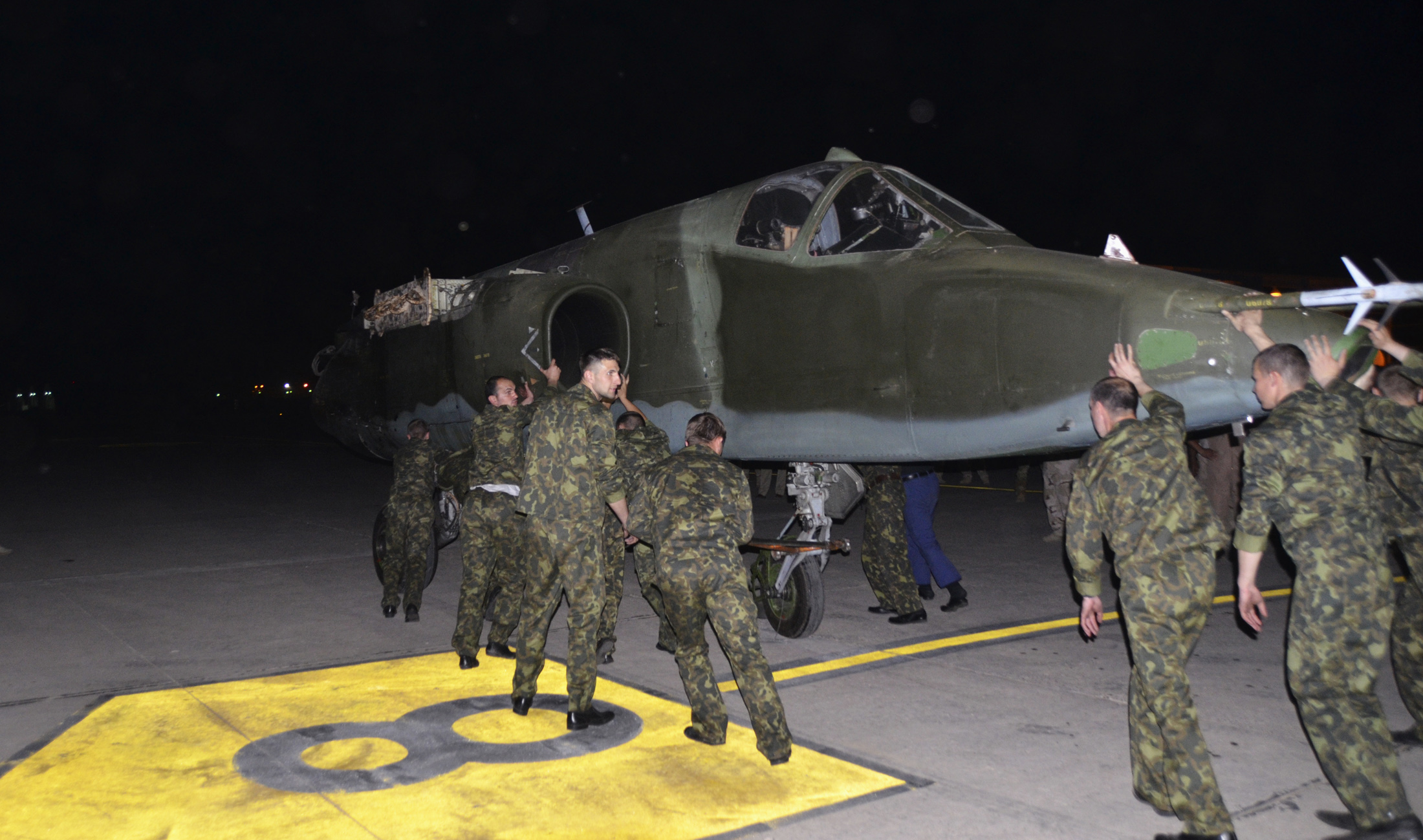
The lone acknowledged confrontation between a U.S.-made F-16 jet fighter and a Soviet Su-25 warplane took place over Pakistan near the Afghan border on August 4, 1988. The Pakistani F-16 destroyed the Su-25 with a missile, reportedly after it had strayed into Pakistani air space during Moscow’s occupation of Afghanistan.
Now a second dogfight between this pair of 20th Century war birds is underway. But the Su-25 appears to be winning. This time, it’s not in the sky, but on the ground: Iraq wants those warplanes on its runways and in its inventory as soon as possible so they can be flown into the fight against the rebels of the Islamic State of Iraq and Syria, who are threatening to topple the U.S.-backed Iraqi government.
The U.S. has sold Iraq 36 speedy F-16s for $3 billion, but the first pair isn’t slated to arrive in Iraq until September. So Iraq has turned to a pair of former Soviet republics, Russia and Belarus, and is buying used Su-25s, lumbering “low and slow” aircraft like the U.S. Air Force’s A-10 Warthog, from them. Moscow apparently has accelerated delivery of the already-ordered planes at Baghdad’s urgent request.
Think of it as the military equivalent of the half-a-loaf argument: when your nation is in danger of collapsing, aging Su-25s beat brand-new F-16s every time.
“The United States remains committed to delivering the F-16s to Iraq as quickly as possible,” White House spokesman Josh Earnest said Monday, blaming some of the delay on the “completion of required financial and administrative details, which the Iraqi government has been slow to complete.” The U.S. plans to deliver two F-16s to Iraq monthly beginning in the fall, with all 36 delivered by 2016.
Amid all the geo-politicking over Iraq’s future, its choice of airplanes now that it’s in extremis highlights what’s good and bad about U.S. military hardware. It is, by most accounts, the best in the world—but the ponderous bureaucracy associated with its delivery, financing, training and logistics means that while it may be suited for tomorrow’s conflicts, it isn’t much help in today’s.
Iraq took delivery of its first F-16 June 5 at the Lockheed factory in Fort Worth where it was built (it still needs more work before they’re ready for delivery). Iraq’s ambassador to the U.S., Lukman Faily, expressed delight. “It gives us the confidence that we can have enough capability of our own that we can protect the borders, to be able to protect our pipelines, and more importantly to deal with any threat of terrorism,” he said at the handover ceremony.
Five days later, ISIS took Mosul, and Iraq no longer seemed satisfied with Washington’s F-16 delivery schedule. “I’ll be frank and say that we were deluded when we signed the contract” for the F-16s, Iraqi Prime Minister Nouri al-Maliki told the BBC last week, complaining that the process was “long-winded.” He said Iraq would have been better off trying “to buy other jet fighters like British, French and Russian to secure the air cover for our forces; if we had air cover we would have averted what had happened.”
Certainly, the Su-25 (NATO nickname: Frogfoot; Russian nickname: Grach, Russian for Rook) is better-suited for plinking terrorists down below than the F-16. An initial batch of five reportedly arrived in Iraq on Saturday, part of a bigger package totaling 12 aircraft and the personnel needed to keep them flying. “The Sukhoi Su-25 is an air-ground support and anti-terrorism mission aircraft,” Iraqi Army Lieut. General Anwar Hamad Amen Ahmed told Russia’s RT news service. “In these difficult times, we are in great need of such aircraft.”
Iraq flew Su-25 attack planes during the 1980-1988 war with Iran. That means there’s an aging cohort of Iraqi pilots who could be flying the planes pretty quickly, Pentagon officials say. Iraq hopes to have the planes attacking ISIS targets within days. “God willing within one week this force will be effective and will destroy the terrorists’ dens,” Maliki said.
ITAR-TASS, the Russian news service, has repeatedly jabbed at the slowness of the U.S. deliveries in recent days. “Iraq has requested Russia to urgently supply Su-25 (Frogfoot) ground attack aircraft over Washington’s delay in delivering F-16 fighters,” one dispatch said.
But that’s not quite correct. The F-16 deliveries haven’t been delayed. “There’s been no slow-rolling,” Rear Admiral John Kirby, the Pentagon spokesman, said Friday. “I’ve said it from here for the last several months that the first deliveries, the first two were scheduled to be delivered in the fall… I don’t know how one can make the case that we’re slow-rolling it when they weren’t even supposed to be delivered for another few months.”
But Army Colonel Steven Warren said Monday that the insurgency has forced the evacuation of contractors from the base north of Baghdad readying for the F-16s’ arrival. “I don’t have a specific timeline for how the relocation of contractors from Balad will affect the delivery of the F-16s,” he said. “It certainly will.”
More Must-Reads from TIME
- Inside Elon Musk’s War on Washington
- Meet the 2025 Women of the Year
- The Harsh Truth About Disability Inclusion
- Why Do More Young Adults Have Cancer?
- Colman Domingo Leads With Radical Love
- How to Get Better at Doing Things Alone
- Cecily Strong on Goober the Clown
- Column: The Rise of America’s Broligarchy
Contact us at letters@time.com



